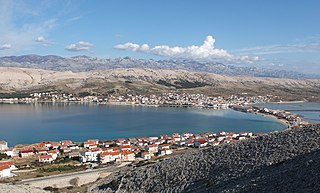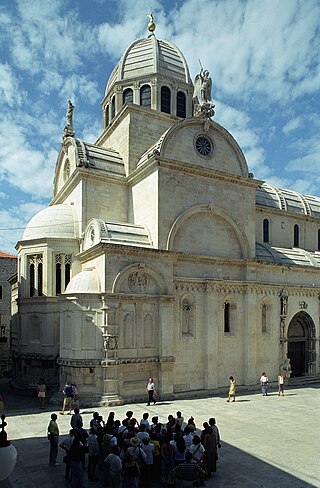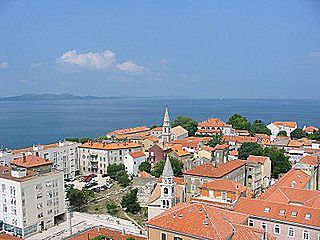
Zadar, historically known as Zara, is the oldest continuously inhabited city in Croatia. It is situated on the Adriatic Sea, at the northwestern part of Ravni Kotari region. Zadar serves as the seat of Zadar County and of the wider northern Dalmatian region. The city proper covers 25 km2 (9.7 sq mi) with a population of 75,082 in 2011, making it the second-largest city of the region of Dalmatia and the fifth-largest city in the country.

Pag is the largest town on the island of Pag, with a population of 2,343 (2021) in the urban core and 3,178 in the entire municipality.

Giovanni Dalmata, born Ioannes Stephani Duknovich de Tragurio, also known as Giovanni Duknovich di Traù in Italy and Ivan Stjepanov Duknović in Croatia, was a sculptor from Trogir, Dalmatia, who was mainly active in Rome, Hungary and his native country during the European Renaissance. Dalmata was, with Mino da Fiesole and Andrea Bregno, one of the leading sculptors in Rome in the second half of the 15th century.
Luciano Laurana was a Dalmatian Italian architect and engineer from the historic Vrana settlement near the town of Zadar in Dalmatia, After education by his father Martin in Vrana settlement, he worked mostly in Italy during the late 15th century. He was principal designer of the Palazzo Ducale of Urbino and one of the main figures in 15th-century Italian architecture. He considerably influenced the development of Renaissance architecture. His projects were accompanied with notes in the Croatian glagolitic script, as witnessed by the famous Bernardo Baldi. He was a relative of the sculptor Francesco Laurana.

Schiavone is an Italian ethnonym literally meaning "Slavs" in Old Venetian: originally, this term indicated origins in the lands of Dalmatia and Istria, when under the rule of the Republic of Venice. Today it is an Italian surname.

The Cathedral of St. James in Šibenik, Croatia, is a triple-nave Catholic basilica with three apses and a dome. It is the episcopal seat of the Šibenik diocese. It is also the most important architectural monument of the Renaissance in the entire country. Since 2000, the cathedral has been on the UNESCO World Heritage List.
Events from the year 1520 in art.

Giorgio da Sebenico or Giorgio Orsini or Juraj Dalmatinac was a Venetian sculptor and architect from Dalmatia, who worked mainly in Sebenico, and in the city of Ancona, then a maritime republic.

Francesco Laurana, also known as Francesco de la Vrana was a Dalmatian sculptor and medallist. He is considered both a Croatian and an Italian sculptor. Though born in the territory of the Republic of Venice, he spent his mature career at the other end of Italy, moving between Naples and Sicily, and Urbino, and finally in southern France, where he died.

Dalmatian Italians are the historical Italian national minority living in the region of Dalmatia, now part of Croatia and Montenegro.
Croatian art describes the visual arts in Croatia, and art by Croatian artists from prehistoric times to the present. In Early Middle Ages, Croatia was an important centre for art and architecture in south eastern Europe. There were many Croatian artists during the Medieval period, and the arts flourished during the Renaissance. Later styles in Croatia included Baroque and Rococo.

The Renaissance in Croatia is a period of cultural enrichment in Croatia that began at the middle of the 15th century and lasted until the end of the 16th century.

Kruno Prijatelj (1922–1998), was a Croatian art historian, art critic and University professor.

Giorgio Schiavone, or Juraj Ćulinović, was a Croatian Renaissance painter, active in North Italy and Dalmatia. He is considered the most important Croatian painter of the 15th century.
Split city derby or Derby of St. Duje is the name given to matches between Hajduk and RNK, two clubs from the Adriatic city of Split. The teams are supported by their fanbases called Hajduk's Torcida and Split's Crveni đavoli. Games are played on two nearby stadiums, Poljud and Park Mladeži.
The Classical Gymnasium was a gymnasium high school situated in Split, Dalmatia, Croatia. It was founded by the Austrian Empire and its Imperial Royal General Government in Dalmatia in 1817. Dalmatian Government, in fact, seceded the public part of the Archidiocesan Classical Gymnasium, founded by archbishop Stefano Cosmi in 1700.










